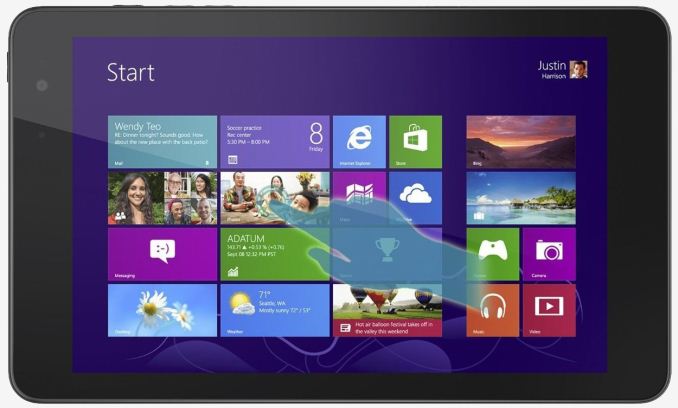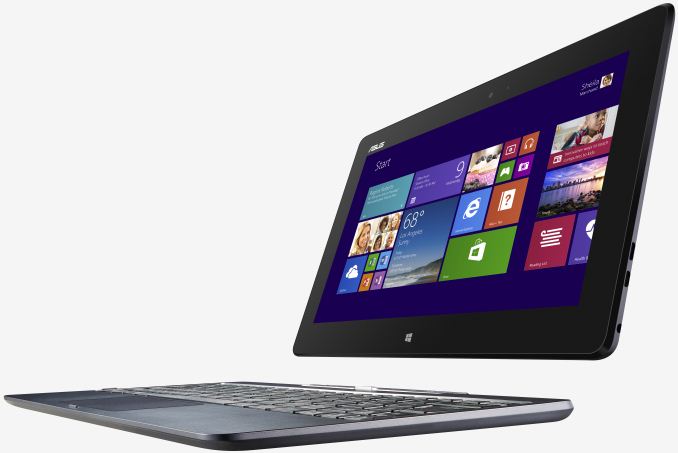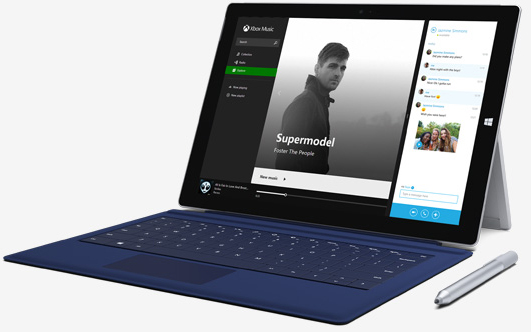Best Tablets: Holiday 2014
by Brandon Chester on November 28, 2014 8:00 AM ESTWindows Tablets
In the early days of Windows 8 tablets, users had to decide between ARM based devices running Windows RT or x86 devices running the standard version of Windows 8 that you would get on a desktop computer. At this point it's fairly safe to say that Windows RT was an utter failure and is dead as a platform. Removing support for every piece of legacy software effectively removed the appeal of running Windows, and efficient x86 processors from Intel have closed the battery life gap between ARM and x86 in the tablet form factor.
For that reason, we haven't seen any big Windows RT tablet launches, and there aren't any that are worth recommending. However, there's a surprisingly large range of prices for Windows tablets, and many double as laptops through convertible designs or keyboard and trackpad attachments. Due to the unique nature of the Windows tablet space, our recommendations here address both price points and special cases of 2-in-1 laptop and tablet hybrids.
The first Windows tablet on our list also happens to be the least expensive of all the tablets. It's HP's recently launched Stream 7 tablet, and it sells for just $119. It's currently available for $20 less at Microsoft's online store, bringing the price down to $99. Before we talk about the tablet itself, it really needs to be stated that it's amazing to see a device running full Windows, and with a full year subscription to Office 365, for $99. Not long ago that $99 would have gotten you a copy of Windows, or a copy of Office. Now you get both, and HP basically throws in a tablet.
The tablet itself isn't bad either, at least relative to its price. Obviously concessions are going to be made to achieve such a low price point, the largest of which is the use of only 1GB of RAM, which will definitely be a limiting factor even on 32-bit Windows 8.1. The omission of 802.11ac is also unfortunate but entirely expected. The rest of the specifications are quite respectable for this price point. The display is a 7" 1280x800 IPS LCD, and the CPU is Intel's Atom Z3735G, a quad core 1.33GHz Bay Trail part with a 1.86GHz burst frequency. For storage you get a 32GB SSD, although it should be noted that a large portion of that is used by Windows. This doesn't leave a lot of space for local files and programs, but it's called the Stream 7 for a reason.
Obviously the Stream 7 isn't going to replace a high end laptop or desktop any time soon. But for someone who needs to have some sort of Windows software available quickly in a small package, it's definitely a good option. I'm interested in it just for the ability to run MPC-HC and madVR on a tablet that can be fueled by videos both in the cloud and on MicroSD storage.
Users looking for a higher end Windows tablet that is still relatively affordable should take a look at the Dell Venue 8 Pro. Normally $299, this tablet is available for $199 from Microsoft's online store during the time surrounding Black Friday. That price gets you similar specifications to the Stream 7, with 32GB of eMMC NAND, a 1.33GHz quad core Atom Z3740D, and an 8" 1280x800 IPS LCD. The biggest improvement is the shift to 2GB of DDR3L-RS memory, clocked at 1600MHz vs 1333MHz in the Stream 7. There are also improvements to the cameras, although I haven't really covered the cameras in any detail with this guide because I don't think they're really a selling point for most people. Without being able to measure the display, it's hard to say if the Venue 8 Pro is worth the premium over the Stream 7 at its normal price of $299. However, at its current sale price of $199 it's definitely worth considering due to the RAM increase alone.
Next up is the 2-in-1 category. I've never really been a fan of devices that try to turn laptops into tablets or tablets into laptops. I find they usually just let me down by not having sufficient hardware to do any sort of productivity tasks where I would appreciate the keyboard input. But for users who just want to have the option to type some notes or surf the web using a keyboard and mouse, they certainly have some appeal. In this category the ASUS Transformer Book T100 is one of the only devices available at the moment, and it hovers around $329.
The T100 actually came out in 2013, and it impressed us at that time. It has a 10.1" 1366x768 IPS display, a 1.33GHz quad core Atom Z3740, and 2GB of RAM. Since it released, there hasn't been much improvement in this product category, owing to the fact that we are just now seeing Intel's Core M parts begin to ship. Anyone looking to get a Windows tablet with a keyboard attachment should know that it won't be long before devices like the ASUS Transformer Book T300 Chi start shipping with significantly improved displays and processors, and unless you really need a device right now, you'll be better off waiting.
At the end of our Windows recommendations we have another device that's a tablet with a keyboard and trackpad attachment, but this one sits firmly in the price territory of laptops. Some would argue it really is considered a laptop rather than a tablet, but Microsoft's own marketing about the Surface Pro 3 would disagree. Microsoft's tablet bills itself as the tablet that can replace your laptop, and like many laptops, it comes in many different varieties. We've laid out the different SKUs in a chart below.
| Microsoft Surface Pro 3 Configuration Options | |||||||||||
| Configuration | $799 | $999 | $1299 | $1549 | $1949 | ||||||
| CPU | Intel Core i3-4020Y | Intel Core i5-4300U | Intel Core i5-4300U | Intel Core i7-4650U | Intel Core i7-4650U | ||||||
| TDP | 11.5W | 15W | 15W | 15W | 15W | ||||||
| Cores/Threads | 2/4 | 2/4 | 2/4 | 2/4 | 2/4 | ||||||
| Frequency Base/Max Turbo | 1.5GHz/- | 1.9/2.9GHz | 1.9/2.9GHz | 1.7/3.3GHz | 1.7/3.3GHz | ||||||
| GPU | Intel HD 4200 | Intel HD 4400 | Intel HD 4400 | Intel HD 5000 | Intel HD 5000 | ||||||
| GPU EUs | 20 | 20 | 20 | 40 | 40 | ||||||
| GPU Frequency Base/Max Turbo | 200/850MHz | 200/1100MHz | 200/1100MHz | 200/1100MHz | 200/1100MHz | ||||||
| Storage | 64GB SSD | 128GB SSD | 256GB SSD | 256GB SSD | 512GB SSD | ||||||
| RAM | 4GB | 4GB | 8GB | 8GB | 8GB | ||||||
As you can see, there's a large price range for the Surface Pro 3, although all of them are well above what most people would consider paying for a tablet. But for anyone who needs a tablet running full Windows, and more hardware power than is available with any of Intel's Bay Trail processors, the Surface Pro 3 is as good as it gets. Microsoft's marketing positions it against other laptops, and with the hardware it provides it really can do anything an Ultrabook can. It should be noted that the type cover is still a separate accessory that costs $129, and with that cost even the Core i3 based Surface Pro 3 is pushed strictly into Ultrabook pricing. For what it offers, I don't think the pricing is unfair, although I do wish that the Core i3 model came with 128GB of storage.
The Surface Pro 3 is definitely aimed at a specific group of users, and I doubt there will be any cross shopping between it and the other tablets listed, unless one is contemplating buying the most expensive model of the iPad Air 2. Anyone who is looking for a tablet that allows for serious productivity should give it a look though, as it's well worth its cost.














87 Comments
View All Comments
Flunk - Friday, November 28, 2014 - link
The idea that WinRT is tied to Win32 isn't actually true. the idea is to abstract the underlying interface so they can change the underpinnings later. Microsoft has already done this with Windows Phone so I wouldn't count on WinRT relying on Win32 forever. That is assuming WinRT ever catches on and that's not exactly a given right now.Penti - Saturday, November 29, 2014 - link
Nah, it abstracts Win32 so it does require Win32 and to remove stuff there you'd also have to remove them in Windows Runtime. It needs to hook into it even if it doesn't run directly on it. You will need both "Windows" and "Win32" code to run it. WP wouldn't work without it's Win32-parts either, neither did Windows Phone 7.X run Windows Runtime or even Windows Phone Runtime.Stuff like VLC can't be built with MSVC so it's not that easy to use in WinRT.
Samus - Friday, November 28, 2014 - link
There are a lot of great media player options for Windows. I feel VLC has fallen behind even Media Player Classic. The only thing it does better is subtitles (which often require an annoying filter\wrapper on MPC.)I personally run XBMC on my convertible laptop (HP Revolve G2) because it has the nicest touch interface.
Penti - Friday, November 28, 2014 - link
You know most people use these simple Atom-based slates with keyboard and mouse in some capacity. The real problem is lack of memory (RAM) and storage. The browser is a Win32-application btw. So is most of the startscreen, it's just the store apps that's not. Office will never have a hybrid touch solution run inside the startscreen, it will be the Win32 version and Store versions that's dumbed down and essentially built on the Office Mobile solution, not geared at professional use.People even use 60% mechanical keyboards with these things. See the 7-10-inch Atom slates as a kind of new netbook. Atom is plenty fast for browsing, and for all the older and most new apps that doesn't lean too heavily on graphics. Most Atom slates are 32-bit though, and RAM will be the biggest limit apart from slow (small) storage.
mabellon - Friday, November 28, 2014 - link
WinRT is the API set replacing Win32 for application development. WinRT is the framework for developing all the modern apps on Windows 8. "Windows RT" is Windows 8 compiled for ARM processors and probably what you are talking about.basroil - Saturday, November 29, 2014 - link
"you really can't use that old software with a touch interface, it is worst than terrible... so WinRT was actually fine for a tablet."I have a Surface Pro 3 and regularly use it with "legacy" apps that don't support the new windows touch system. Not a single issue (outside of those that use opengl or dx for interaction and were made with XP in mind) as long as the UI was designed with limited menus (the bane of any touch device's existence) and large or adjustable buttons/sliders (a surprisingly large percent of good programs). With the Surface Pro 3 though, you also have the option of the pen, which mimics a mouse input for old software (in fact, it'll be indistinguishable from a mouse to anything that doesn't have win 8 specific input filters, including Photoshop CS6, unless you install the wintab driver) and can be used identically to a mouse in 100% of click scenarios (though only GDI type programs will support right click hold, opengl/dx buffered screens will ignore the right click hold)
Gich - Sunday, November 30, 2014 - link
"as long as the UI was designed with limited menus (the bane of any touch device's existence) and large or adjustable buttons/sliders (a surprisingly large percent of good programs)." I don't feel it's a large percentage that get those criteria.The pen is the sobstitute of the mouse, and it was indeed the standard for the "original tablet pc" but it's not so common now, nowdays for the "modern tablets" I'd say you expect to be able to use just fingers... pen is a niche, mostly for professional users.
basroil - Saturday, November 29, 2014 - link
"you really can't use that old software with a touch interface, it is worst than terrible... so WinRT was actually fine for a tablet."I have a Surface Pro 3 and regularly use it with "legacy" apps that don't support the new windows touch system. Not a single issue (outside of those that use opengl or dx for interaction and were made with XP in mind) as long as the UI was designed with limited menus (the bane of any touch device's existence) and large or adjustable buttons/sliders (a surprisingly large percent of good programs). With the Surface Pro 3 though, you also have the option of the pen, which mimics a mouse input for old software (in fact, it'll be indistinguishable from a mouse to anything that doesn't have win 8 specific input filters, including Photoshop CS6, unless you install the wintab driver) and can be used identically to a mouse in 100% of click scenarios (though only GDI type programs will support right click hold, opengl/dx buffered screens will ignore the right click hold)
kron123456789 - Friday, November 28, 2014 - link
Thats interesting — two of three best android tablets are based on Tegra K1. Btw, where is Nexus 9 review? It's been over two weeks since "Preliminary Findings".redviper - Friday, November 28, 2014 - link
The Asus vivotab note 8 is a better option than the DVP8. I have the DVP8 and the pen is a disaster, I'd really rather get the Asus. Ofcourse if they come out with some processor/screen/ram update that would be a really nice tablet, but MS is pushing low end for everything but Surface now.